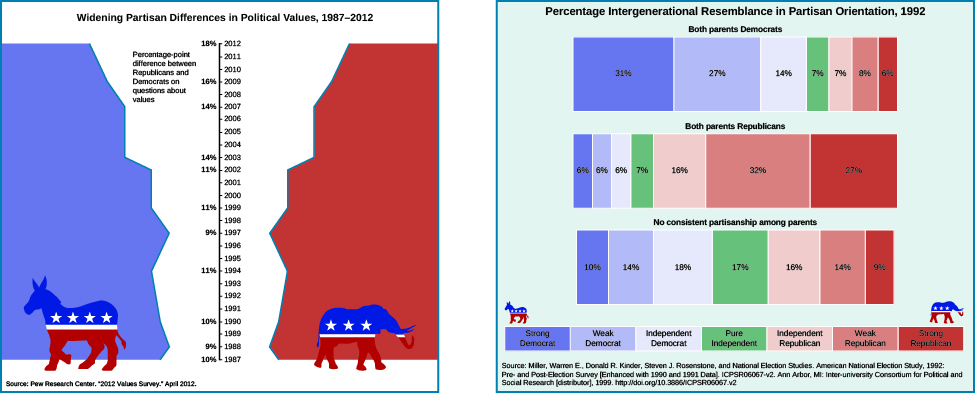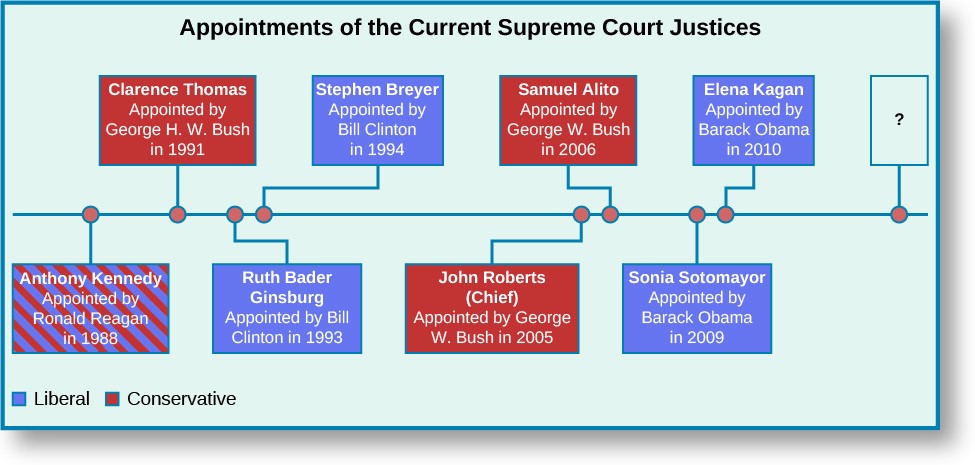3.1: Preface
- Page ID
- 82584
Welcome to American Government, an OpenStax resource. This textbook was written to increase student access to high-quality learning materials, maintaining the highest standards of academic rigor at little to no cost.
ABOUT OPENSTAX
OpenStax is a nonprofit based at Rice University, and it’s our mission to improve student access to education. Our first openly licensed college textbook was published in 2012 and our initiative has since scaled to over 20 books used by hundreds of thousands of students across the globe. Our adaptive learning technology, designed to improve learning outcomes through personalized educational paths, is currently being piloted for K–12 and college. The OpenStax mission is made possible through the generous support of philanthropic foundations. Through these partnerships and with the help of additional low-cost resources from our OpenStax partners, OpenStax is breaking down the most common barriers to learning and empowering students and instructors to succeed.
ABOUT OPENSTAX RESOURCES
Customization
American Government is licensed under a Creative Commons Attribution 4.0 International (CC BY) license, which means you can distribute, remix, and build upon the content, as long as you credit OpenStax for the original creation.
Because our books are openly licensed, you are free to use the entire book or pick and choose the sections that are most relevant to the needs of your course. Feel free to remix the content by assigning your students select chapters and sections in your syllabus, in the order that you prefer. You can even provide a direct link in your syllabus to the sections in the web view of your book.
Errata
All OpenStax textbooks undergo a rigorous review process. However, like any professional-grade textbook, errors sometimes occur. Since our books are web-based, we can make updates periodically when deemed pedagogically necessary. If you have a correction to suggest, submit it through the link on your book page on openstax.org. All errata suggestions are reviewed by subject matter experts. OpenStax is committed to remaining transparent about all updates, so you will also find a list of past errata changes on your book page on openstax.org.
Format
You can access this textbook for free in web view or PDF through openstax.org, and for a low cost in print.
ABOUT AMERICAN GOVERNMENT
American Government is designed to meet the scope and sequence requirements of the single-semester American Government course. This title includes innovative features designed to enhance student learning, including Insider Perspective features and a Get Connected module that shows students how they can get engaged in the political process. The book provides an important opportunity for students to learn the core concepts of American Government and understand how those concepts apply to their lives and the world around them.
Coverage and Scope
Our American Government textbook adheres to the scope and sequence of introductory American government courses nationwide. We have endeavored to make the workings of American Government interesting and accessible to students while maintaining the conceptual coverage and rigor inherent in the subject at the college level. With this objective in mind, the content of this textbook has been developed and arranged to provide a logical progression from the fundamental principles of institutional design at the founding, to avenues of political participation, to thorough coverage of the political structures that constitute American government. The book builds upon what students have already learned and emphasizes connections between topics as well as between theory and applications. The goal of each section is to enable students not just to recognize concepts, but to work with them in ways that will be useful in later courses, future careers, and as engaged citizens. The organization and pedagogical features were developed and vetted with feedback from American government instructors dedicated to the project.
Unit I: Students and the System
- Chapter 1: American Government and Civic Engagement
- Chapter 2: The Constitution and Its Origins
- Chapter 3: American Federalism
Unit II: Individual Agency and Action
- Chapter 4: Civil Liberties
- Chapter 5: Civil Rights
- Chapter 6: The Politics of Public Opinion
- Chapter 7: Voting and Elections
Unit III: Toward Collective Action: Mediating Institutions
- Chapter 8: The Media
- Chapter 9: Political Parties
- Chapter 10: Interest Groups and Lobbying
Unit IV: Delivering Collective Action: Formal Institutions
- Chapter 11: Congress
- Chapter 12: The Presidency
- Chapter 13: The Courts
- Chapter 14: State and Local Government
Unit V: Outputs of Government
- Chapter 15: The Bureaucracy
- Chapter 16: Domestic Policy
- Chapter 17: Foreign Policy
Appendixes
- Appendix A: Declaration of Independence
- Appendix B: The Constitution of the United States
- Appendix C: Federalist Papers #10 and #51
- Appendix D: Electoral College Votes by State, 2012–2020
- Appendix E: Selected Supreme Court Cases
Engaging Feature Boxes
Throughout American Government, you will find features that engage students by taking selected topics a step further. Our features include:
- Get Connected! This feature shows students ways they can become engaged in the U.S. political system. Follow-up may include an activity prompt or a discussion question on how students might address a particular problem.
- Finding a Middle Ground. This feature highlights a tradeoff or compromise related to the chapter’s content area. Follow-up questions guide students to examine multiple perspectives on an issue, think critically about the complexities of the topic, and share their opinion.
- Insider Perspective. This feature takes students behind the scenes of the governmental system to see how things actually work. Follow-up questions ask students for their reaction to this peek inside the “black box” of politics.
- Link to Learning. This feature provides a very brief introduction to a website that is pertinent to students’ exploration of the topic at hand. Included in every module, Link to Learning boxes allow students to easily connect to the most current data of ever-changing content such as poll research, budget statistics, and election coverage.
- Milestone. This feature looks at a key historical moment or series of events in the topic area. Follow-up questions link the milestone to the larger chapter theme and probe students’ knowledge and opinions about the events under discussion.
Effective Art Program
Our art program is designed to enhance students’ understanding of concepts through clear and effective statistical graphs, tables, and photographs.


Module Materials That Reinforce Key Concepts
- Learning Objectives. Every module begins with a set of clear and concise learning objectives. These objectives are designed to help the instructor decide what content to include or assign, and to guide students with respect to what they can expect to learn. After completing the module and end-of-module exercises, students should be able to demonstrate mastery of the learning objectives.
- Summaries. Section summaries distill the information in each module for both students and instructors down to key, concise points addressed in the section.
- Key Terms. Key terms are bold and are followed by a definition in context. Definitions of key terms are also listed in the Glossary, which appears at the end of the module online and at the end of the chapter in print.
- Assessments. Multiple-choice and short-answer Review Questions provide opportunities to recall and test the information students learn throughout each module. End-of-chapter Critical Thinking Questions encourage deeper reflection on the chapter concepts and themes.
- Suggestions for Further Study. This curated list of books, films, and online resources helps students further explore the chapter topic.
ADDITIONAL RESOURCES
Student and Instructor Resources
We’ve compiled additional resources for both students and instructors, including Getting Started Guides, PowerPoint slides, and an Instructor Answer Guide. Instructor resources require a verified instructor account, which can be requested on your openstax.org log-in. Take advantage of these resources to supplement your OpenStax book.
Partner Resources
OpenStax partners are our allies in the mission to make high-quality learning materials affordable and accessible to students and instructors everywhere. Their tools integrate seamlessly with our OpenStax titles at a low cost. To access the partner resources for your text, visit your book page on openstax.org.
ABOUT THE AUTHORS
Senior Contributing Authors
Glen Krutz (Content Lead), University of Oklahoma
Dr. Glen Krutz received his BA and MPA from the University of Nevada–Reno, and his PhD from Texas A&M University. He joined the University of Oklahoma’s Department of Political Science in 2002 and serves as Professor of Political Science, teaching the American Government course to hundreds of students each semester. Prior to his academic career, Dr. Krutz worked in politics and policy, as a campaign assistant and then Capitol Hill aide to a U.S. senator, and as a research analyst for what would become the Nevada System of Higher Education. He has authored and co-authored several books, and his work has appeared in numerous leading journals. Dr. Krutz’s current research probes questions of public policy agenda-setting in democratic political institutions, especially Congress.
Sylvie Waskiewicz (Lead Editor), PhD
Dr. Waskiewicz received her BSBA from Georgetown University and her MA and PhD from the Institute of French Studies at New York University. With a specialization in Franco-American relations and over ten years of teaching experience at the university level, Sylvie left academia to join the ranks of higher education publishing. She has spent the last nine years editing college textbooks and academic journals in the humanities, social sciences, and world languages.
Contributing Authors
Prosper Bernard, Jr., City University of New York
Jennifer Danley-Scott, Texas Woman’s University
Ann Kordas, Johnson & Wales University
Christopher Lawrence, Middle Georgia State College
Tonya Neaves, George Mason University
Adam Newmark, Appalachian State University
Brooks D. Simpson, Arizona State University
Joel Webb, Tulane University
Shawn Williams, Campbellsville University
Rhonda Wrzenski, Indiana University Southeast
Reviewers
Brad Allard, Hill College
Milan Andrejevich, Ivy Tech Community College
Thomas Arndt, Rowan University
Sue Atkinson, University of Maryland–University College
Edward Bond, Alabama A&M University
Joseph Campbell, Rose State College
James Davenport, Rose State College
Sharon Deubreau, Rhodes State College
Henry Esparza, University of Texas–San Antonio
Terri Fine, University of Central Florida
Mark Francisco, Volunteer State Community College
Sarah Gershon, Georgia State University
Rick Gianni, Indiana University Northwest
Travis Grasser, Commerce High School
Eric Herzik, University of Nevada–Reno
Matthew Hipps, Dalton State College
Alexander Hogan, Lone Star College–CyFair
Cynthia Hunter-Summerlin, Tarrant County College
Tseggai Isaac, University of Missouri-Rolla
Walter Jatkowski, III, Northwest College
Kevin Jeffries, Alvin Community College
J. Aaron Knight, Houston Community College
Robert Lancaster, Kentucky State University
John Lund, Keene State College
Shari MacLachlan, Palm Beach State College
Carol Marmaduke-Sands, North Central Texas College
James McCormick, Iowa State University
Eric Miller, Blinn College
Sara Moats, Florida International University
Marie Natoli, Emmanuel College
Caryn Neumann, Miami University of Ohio
James Newman, Southeast Missouri State University
Cynthia Newton, Wesley College
Jeffrey S. Peake, Clemson University
G. David Price, Santa Fe College
James Ronan, Rowan University
David Smith, Texas A&M University-Corpus Christi
Leniece Smith, Jackson State University
Kai Sorensen, Central Michigan University
James Starkey, Pasadena City College
Karen Stewart, Collin College
Abram Trosky, United States Coast Guard Academy
Adam Warber, Clemson University
Alexander Wathen, University of Houston–Downtown
Reed Welch, West Texas A&M University
Yvonne Wollenberg, Rutgers University
John Wood, University of Central Oklahoma
Laura Wood, Tarrant County College
Michael Zarkin, Westminster College
- American Government. Authored by: OpenStax. Provided by: OpenStax; Rice University. Located at: https://cnx.org/contents/W8wOWXNF@12.1:Y1CfqFju@5/Preface. License: CC BY: Attribution. License Terms: Download for free at http://cnx.org/contents/9e28f580-0d1...c48329947ac2@1.

